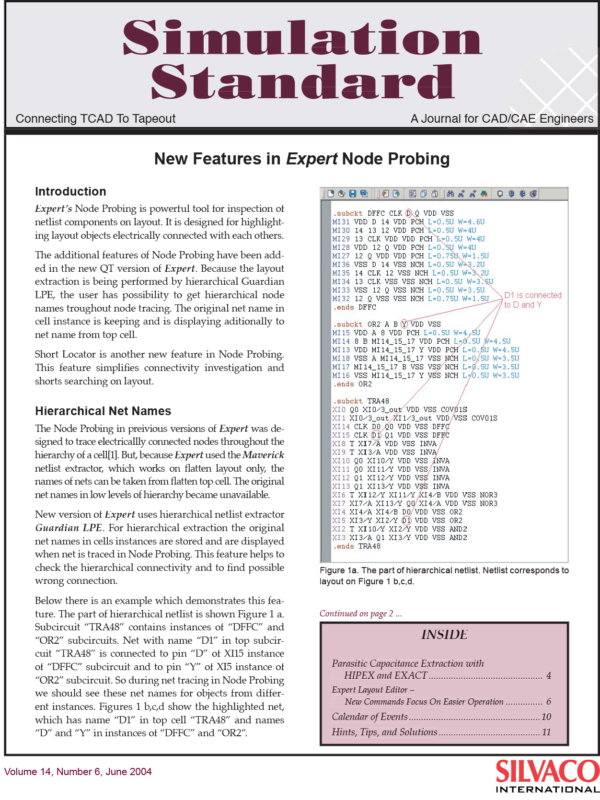New Features in Expert Node Probing
Introduction
Expert’s Node Probing is powerful tool for inspection of netlist components on layout. It is designed for highlighting layout objects electrically connected with each others.
The additional features of Node Probing have been added in the new QT version of Expert. Because the layout extraction is being performed by hierarchical Guardian LPE, the user has possibility to get hierarchical node names troughout node tracing. The original net name in cell instance is keeping and is displaying aditionally to net name from top cell.
Short Locator is another new feature in Node Probing. This feature simplifies connectivity investigation and shorts searching on layout.
Hierarchical Net Names
The Node Probing in preivious versions of Expert was designed to trace electricallly connected nodes throughout the hierarchy of a cell[1]. But, because Expert used the Maverick netlist extractor, which works on flatten layout only, the names of nets can be taken from flatten top cell. The original net names in low levels of hierarchy became unavailable.
New version of Expert uses hierarchical netlist extractor Guardian LPE. For hierarchical extraction the original net names in cells instances are stored and are displayed when net is traced in Node Probing. This feature helps to check the hierarchical connectivity and to find possible wrong connection.
Below there is an example which demonstrates this feature. The part of hierarchical netlist is shown Figure 1 a. Subcircuit “TRA48” contains instances of “DFFC” and “OR2” subcircuits. Net with name “D1” in top subcircuit “TRA48” is connected to pin “D” of XI15 instance of “DFFC” subcircuit and to pin “Y” of XI5 instance of “OR2” subcircuit. So during net tracing in Node Probing we should see these net names for objects from different instances. Figures 1 b,c,d show the highlighted net, which has name “D1” in top cell “TRA48” and names “D” and “Y” in instances of “DFFC” and “OR2”.
Short Locator
Short Locator is a new feature of the Node Probing in Expert. It permits to simplify search of shorts in layout. Short Locator is based on well known Dijkstra’s algorithm for shortest-paths problem [2].
Short Locator works with the net selected by Node Probing. To build a graph for Dijkstra’s algorithm the geometrical objects from highlighted net are splitted into set of trapezoids. The trapezoids from one layer touch each other but don’t overlap. The middle points of common parts of edges of these trapezoids became graph vertexes. Each set of connected objects from one layer produces own subgraph. Subgraphs are combined to one graph using additional graph vertexes which are centers of overlapping area of two trapezoids from diffrent connected layers.
Figure 2 shows small example. There are three layers M1, M2 and Contact. Layer M1 has electrical connection with layer Contact and layer M2 has electrical connection with layer Contact too, but there is no direct connection between M1 and M2. Wire from layer M1 is splitted to 3 trapezoids and wire from layer M2 is splitted to 2 trapezoids. The orginal graph consists from 4 points A,B,C,D. Points 1 and 2 are added to graph when short path between these points are searched.



